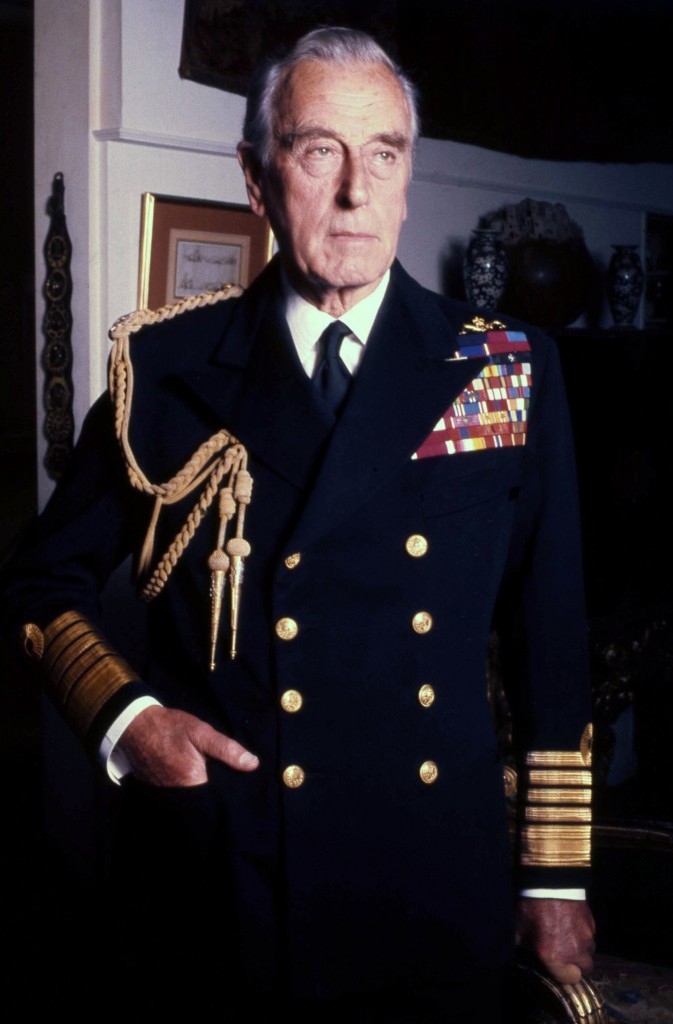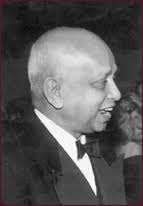Life Abroad – 123 FASCINATING STORY – Pt. 2
Posted on April 9th, 2015
Dr. Tilak S. Fernando
SIR OLIVER GOONATILLAKE & LORD MOUNTBATTEN
Continuation of a fascinating true to life story of Wijesim Peelige Bandiya, son of a Kandyan ‘ hack & burn’ peasant farmer, who sailed away from the Colombo harbour to the UK at a very tender age, with only three Australian pounds in his pocket, accompanied by Sir Oliver Goonatillake in 1948, married a German girl and transformed his life into something unimaginable over the years and returned to his roots as a ‘ laxapathiya’ (millionaire) and is now settled in a spacious house at the age of 86 with his brother Wijesim Peelige Ran Kira, 98 years old in Pahatha Dumbara, Kandy. Following are excerpts from an interview the writer had recently in Kandy with Wijesim Pelige Bandiya. Part II
Mrs. Grace Matilda de Silva was the elder sister of the late Sir Oliver Goonatilake. Rev. D. Silva and Grace Matilada had two sons. Wijesim Peelige Bandiya (re-christened as ‘Peter Wijesinghe’) remembers the 1947 legendary floods in Kandy when their teenage son, Ernest de Silva, drowned and died in the floods
During this period the late Sir Oliver Goonatilake’s family lived in Kandy at Nagarasabha Handiya. Sir Oliver’s father, A. E. Goonatillake, being a postmaster in Sri Lanka, was known as Ralahamy or Redda Assé Mahattaya” (gentleman’s outfit consisted of a pair of trousers and a cloth wrapped over the trousers up to knee length, where half of the trousers was visible). A jacket or coat covered the upper torso area.
Rev. De Silva and Sir Oliver Goonatilake’s family were close neighbours. Peter being resident at the time at Rev. De Silva’s bungalow had easy access to the Goonatilakes frequently. Finally when Rev. De Silva got transferred to Ja-ela diocese Wijesinghe was sent to live with the Goonatillake family.
Rev. De Silva and Grace Matilda’s daughter got married to J.C.A. Corea, who was the Principal at Kings Wood College at the time. Upon J.C.A.Corea’s succession as Principal at the Royal College, Colombo at retirement of the outgoing principal Mr. Radby, Corea moved to a residence at 20, Reed Avenue, Colombo 7. Subsequently, when a person named Banda who worked as the office peon at the Royal College, ‘Peter Wijesinghe’ was recruited and substituted for Banda’s vacancy to work for the Principal J.C.A. Corea – the new principal.
During 1940 Sir Oliver Goonatillake was a big wig in the government and worked as the CDC (Civil Defence Commissioner); he was also a Member of the War Council, Ceylon. During the World War II when Singapore ‘collapsed’, Admiral of the Fleet Louis Francis Albert Victor Nicholas Mountbatten, 1st Earl Mountbatten of Burma, set up his South Asia office in Sri Lanka at Peradeniya Botanical Gardens in Kandy.
Lord Mountbatten was a great friend of Sir Oliver Goonatillake. Peter (Pelige) Wijesinghe recalls him having a secret residence called ‘ 404 Nandana Camp’ at Pilimatalawa. When Lord Mountbatten was looking out for someone trustworthy for his domestic help, Sir Oliver had suggested Peelige Wijesinghe to Lord Mountbatten at which point he was employed for about six months at the Nandana Camp at Pilimatalawa. Subsequently Lord Mountbatten moved into a bungalow situated about 15 minutes from Kandy town on almost six acres of tendered lawn and tea gardens, which today has restored to reflect the life in the bygone Victorian era. The Bungalow’s exclusive accommodation consists of six rooms equipped with all modern amenities and superior comforts.
This century-old residence derived its name by allegedly functioning as a war office during World War II and is said to have used as one of the private residences of Lord Louis Mountbatten, who was a close relative of the British Royal Family.
Mountbatten Medallic History
Mountbatten Medallic History of Great Britain & The Sea is a collection of 100 silver medals or medallions, in hallmarked sterling silver and issued in 1974, struck by John Pinches. This medallic collection illustrates many of the foremost maritime achievements of Great Britain. Chronologically, it represents the Tudor ship-of-war, the Great Harry (Mary Rose) which was built by Henry VIII, who in 1546 established a naval administration”. This (once drowned ship due to heavy artillery it carried) has been recovered and is currently exhibited at Greenwich, South East London.
Peter Wijesinghe believes he could probably be the only Sri Lankan who owns a copy (four volumes) of Mountbatten Medallic History of Great Britain & The Sea, which he purchased in 1980s at a cost of Rs.200,000 ; it has been personally autographed by Lord Mountbatten in his own handwriting which reads : To P. Wijesinghe”.
Independence of Ceylon
In the early 1940s Sir Oliver lived at No. 55 Castle Street, Colombo 7. On 4th February 1948 Ceylon was granted a Dominion status when the Independence celebrations were held at Torrington Square, which was especially built for this purpose as the Duke of Gloucester was expected to visit Ceylon bringing with him the last Sri Lankan King’s Crown and the Throne.
Sir Oliver was in full control and in charge of the celebrations for the 4th of February 1948 celebrations. At midnight of 3rd February 1948, the Union Jack came down while the Sri Lankan National flag was hoisted. Followed by the independence ceremony in Colombo, a repetition of the merriments took place in Kandy from the Queen’s Hotel.
After the Independent celebrations and Ceylon being granted a dominion state, Sir Oliver was posted to London with a special task of looking out for a suitable place to establish an appropriate office for the Ceylon High Commission in London. Sir Oliver’s daughter Sheila, son Ernie and Peter (Peelige) Wijesinghe accompanied the Sir Oliver Goonatillake family to London by ship.
London Base
A wealthy lady named Dorothy Saunders, who was a cherished friend of Sir Oliver, owned a flat at Alfred House in a block of buildings facing Hyde Park along Park Lane, West End of London, which was (is) an upmarket area. Goonatillake family along with Wijesinghe stayed at Alfred House for a few days and later moved to Bray in Hertfordshire, outskirts of London, to Veer Bank stud farm owned by Mrs. Saunders.
Sir Oliver stayed at the farm with his children and the aide for about a year until he managed to source a suitable building for the Ceylon High Commission at 25, Grosvenor Square, London W1 in which Lord Adrian Bailey had been living. Sir Oliver negotiated and the Ceylon government bought it on a long lease for £49,000. It was a fully furnished palatial house with a basement, ground floor, and 1st floor used as the office and 2nd, 3rd and the 4th floors utilised for residential purposes.
Sir Oliver Goonatillake being the very first Sri Lankan High Commissioner in London had the following members as his staff. Velupillai Kumaraswamy as Deputy High Commissioner, L.A. Weerasinghe (Financial Adviser), C.E.P. Jayasooriya (Trade Commissioner), Baku Mahadeva (1st Secretary), Walter Jayawardena (Education Officer), S.P. Christian (Chief Clerk), Mr. Peiris (Once famous pianist’s father (Receptionist) with household staff M.D.Simon, Wijesinghe, Anthony (Chef) Vincent (Domestic assistant from Cochin, India and Pearl Perera. Locally recruited staff included Diane Roe (English), Miss. Allen, Beaton (Boiler man) John Wright Chauffer and Ben Hilson, Commissionaire.
From 25 Grosvenor Square the High Commissioner moved to No.21 Addison Road, Kensington London W8 to his official residence while the chancery moved to 13 Hyde Park Gardens, W2 .
On 8th February 1951 when Sir Oliver Goonatillake was transferred to Ceylon and left the United Kingdom, Sir Oliver had made arrangements to absorb Peter Wijesinghe to the Ceylon High Commission staff officially which was done on the 12th of February 1951 when Velupillai Kumaraswamy was acting as the High Commissioner. ‘ Buluwela’ was employed as the assistant caretaker.
At the time there were only seven High Commission offices in London. Ceylon High Commission being one of the ‘senior’ High Commissions was kept busy with the transference of ‘papers’ between the British Cabinet office and the Privy Council. These ‘ transfer papers’ arrived daily at the Ceylon High Commission from the Commonwealth Relations Office (Centre of distribution) to be distributed to other High Commissions in London that existed at the time.
All papers from the Cabinet office arrived in a Red Box and other documents that needed to be transferred to various departments were received in a Green Box. Deliveries usually arrived at the Ceylon High Commission at late afternoon close upon the end of office hours . Peter Wijesinghe, who was entrusted with the keys to those official boxes, had the task of opening the boxes and to submit them to the Deputy High Commissioner. Any communication that went to the Queen had to be sent inside the relevant box, which in turn was collected by the CRO (Commonwealth Relations Office). At the same time any communication done with the Foreign Ministry in Colombo had to be done with the help of Cypher operation using the Morse code. Similar to the stationmasters in the Ceylon Government Railways communicated with other stations by ‘tap tapping’ method. There was a special book with codes, which enabled the then cypher operator Erene Swan to master the operation.



April 10th, 2015 at 8:18 am
So delighted to read about lord Mountbatten and OEG where latter is a relative of my dad and strange enough Sir John is a relative of my mum where the Artigalle family is connected to the kothlawala family.Most of us lived in kotte,Mirihana not forgetting MadapathaPeople thought that they lived a noble life, ever so generous to people with open free dinners to any one to walk in on a particular day.
Never failed to take a lunch packet to OEG on a sundry to his flat in Bayswater road Marble Arch.Denzil.K used to tag along with me taking Appuhamy’s lunch from the student hostel. Latter years he couldn’t see well and such noble people like him and Sir John were a gift to our country and we miss them immensely.
Mountbatten loved our country as well and his ADC in Kandy one Albert Roe was my lawyer to his end, another gentleman that helped me and others so well.